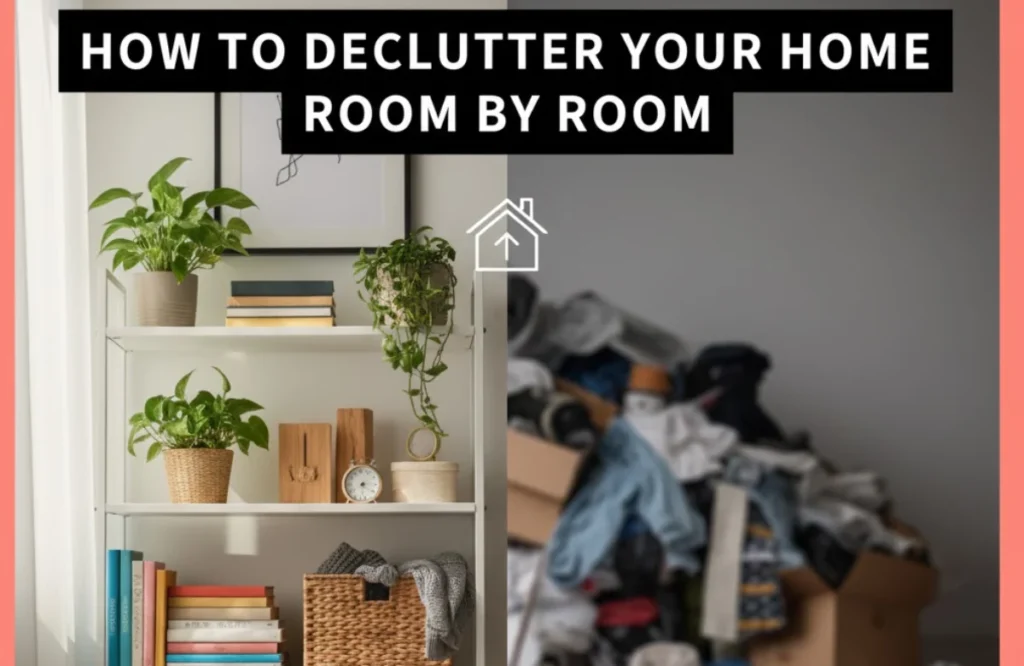This is the ultimate guide on how to declutter your home room by room, your step-by-step roadmap on how to go about turning chaos into calm! The idea of entering every room and immediately experiencing a feeling of calmness, clarity and control is enticing. There will be no longer stumbling on the heaps of mess or searching to find those lost keys or that favorite sweater. You want your kitchen to look like a junk drawer eruption, your wardrobe to appear as if it is at the seams, or your garage to appear like a storage facility, then this guide will have you covered. Decluttering can equally be a complicated matter, but it is quite easy to divide the house into room-by-room, thus making it manageable and even entertaining. Not to mention the payoff: not only a clean house, but a cozy, comfortable one, and one that is yours.
Ready to reclaim your space? Let us get into it and get to know how to declutter your home room by room, starting today!
Why Decluttering Your Home Is Important
Think about your house, where it is a sanctuary and then you can imagine that there is peace and comfort in your place. However, a messy space is like a dense fog; there is a weight pressing upon your mind and soul. Knowing how to clean your home is not simply cleaning it, but getting your serenity, your security, and your sanity back.
Benefits for Mental Health
Clutter is not only a physical disorder, but it is a mental disorder disguised. Your environment is full of trash, so your brain becomes overstimulated by distractions. This causes stress, anxiety and lack of concentration. Research has found that decluttering has the potential to decrease cortisol, alleviating stress and enhancing a clearer mind. When you decide to clean and get organized, you will have created a mood that will inform your brain, Everything is alright here. You will experience a lift in mood, a flow of creativity and anxiety will dissipate.
Physical Health and Safety Advantages
A clean, clutter-free home isn’t just refreshing; it can save your health and life. Excess clutter blocks walkways, increasing fall risk, especially for kids and seniors. Dust accumulates more on piles of stuff, trapping allergens that can aggravate asthma or allergies. When you declutter your home, you’re clearing the way for easier cleaning and making your living spaces safer. Plus, fewer items mean fewer places for pests to hide.
Benefits of Physical Health and Safety
It is not only that a tidy house is a healthy environment, but it can be a lifesaver. Clutters are obstructing walks, thereby causing more fall risk particularly among children and the elderly. Piles of stuff have more dust that accumulates and entraps allergens that can worsen asthma or allergies. When you declutter your home, you are opening up space to clean more easily and make the places where you live safer. In addition, fewer items also translates to fewer hiding places for pests.
How to Declutter Your Home: Getting Started
Starting the decluttering journey can feel overwhelming. The key is taking focused, manageable steps. Here’s how you begin.
Set Clear Goals for Each Room
Make a choice on what you desire in every room. Do you want a calm bedroom? A functional kitchen? Goal setting assists you in having a direction in your effort and a motivational force to work tomorrow. Here is an example: I would like to have my bedroom as a cozy getaway or I would like my living room to seem spacious enough to play games with the family. This intense concentration will put you on the right path as you get rid of declutter home.
Gather Supplies: Boxes, Bags, Labels
The weapons you need before you overcome the clutter are donation boxes, trash bags, and labels so that you can stay organized. Putting a label on every container (e.g., Donate, Recycle, Keep) enables one to keep the process rolling and avoids second-guessing.
Commit to a Timeline
Set a realistic schedule. Decluttering is not a marathon run but is instead a process. Determine whether you want to spend weekends or evenings on it. Already, 15-30 minutes a day can result in dramatic outcomes in weeks. The key is commitment. When you have a timeline, you feel encouraged to continue and not to waste time having no idea what to do.
Decluttering Techniques That Work
Now the fun begins! Different proven methods suit different people. Let’s explore a few.
The “Keep, Donate, Trash” Method
A classic and straightforward approach. On each item, you should be able to ask yourself: Do I keep it (or donate it) or toss it? To keep only the things which are unnecessary or really significant, to give away those which are in good condition and to dispose of the things which are broken or useless. The technique makes your sorting an easy and efficient one.
The KonMari Method: Spark Joy Approach
This technique is popularized by Marie Kondo and involves picking each item and asking the question, does this bring you joy? If yes, keep it. No, thank you very much, goodbye. This makes the process more mindful of your emotions so that you can only hold on to things that make you feel good.
Room-by-Room Decluttering Strategy
Attempting to clean the entire house simultaneously overwhelms the majority of people. Rather, work on a room-by-room basis. Begin with the simplest and proceed to the more difficult areas. This maintains high levels of motivation and progress.
De-clutter and Organize at the same time
Why wait? Decide on what to keep and arrange it at once. Designate each item a place (bin, shelf or drawer). This minimizes the mess afterward and makes you look at your new clean system.
Decluttering tips unique to rooms
Room-Specific Decluttering Tips
Every room has its own quirks and challenges when it comes to clutter.
Declutter Your Living Room
It is the social core of your house but it is usually the place where random stuff is thrown. Begin with cleaning of the surfaces- tables, shelves, floors. Eliminate things that are out of place. Store and group magazines, remotes, books, and toys have baskets or drawers.
Declutter Your Kitchen
The kitchen may end up being messy with spoiled food, idle devices or junk mail. Clean up your pantry and fridge on a regular basis. Give stuff like utensils or appliances that you do not use. Arrange cabinets according to frequency of use: the ones used frequently are easily accessible, the ones used less often are up high or at the rear.
Organize Your Bedroom and Closet
Closets usually become pits of abandoned and no longer fitting clothes. Here, try the KonMari spark joy test with clothes. Give away or reuse the things that do not suit your body or your style anymore. Keep your nightstand surfaces clean to achieve a restful sleep.
Declutter Your Bathroom
There is a rapid accumulation of toiletries, out-of-date medicines, and containers that are empty containers here. Check out of date and dispose of out of date goods often. Put items used by the group every day in trays or transparent containers to maintain good order on counters.
Declutter Home Office and Storage Areas
Offices can be bogged down in paperwork and supplies. Being a digital person, it is important to have important documents digitized where possible. Go through paper stacks periodically and organize and shred the stacks that you do not need. It is more convenient with labels on boxes and stacking the same way in storage rooms.
Maintaining a Clutter-Free Home
Similar to any good thing, proper habits and intelligent systems are essential when you want to keep your home clean.
Daily and Weekly Habits to Keep Clutter Away
Take only 5-10 minutes a day and clean up places that end up with lots of stuff such as countertops or a desk. Lesson Thorough more frequent sweep Every week. Such minor endeavors stop the resurgence of clutter.
Smart Storage Solutions and Organization Tools
Baskets, drawer dividers, hooks, and clear bins can be used to create psychological storage. Label everything to make everyone in the family know where things are. The less difficult a put away thing is, the more one is likely to do it.
Family Involvement and Accountability
Cleaning up is not a one man task when you have other people living with you. The family or roommates should participate in the process to clearly define the shared spaces. Call periodic family sweeping days and share the progress to be made.
Common Decluttering Mistakes to Avoid
Beware these common pitfalls that stunt your declutter and organize journey.
Holding on to Items, Just in Case
The just in case trap is what creates an accumulation of unwanted things. Unless you have a specific idea of how you are going to utilize it, then it has to be discarded in case you have not used it in a few months.
Doing Too Much at Once
Attempting to de-clutter your whole house in a single day only burns and frustrates. Go step by step with goal achievement.
Forgetting to Maintain Decluttered Spaces
The largest error that occurs after tough decluttering processes consists of overlooking maintenance. Aging lapses back into old habits in no time.
Additional Tips and Resources
Boost your success with handy tools and expert advice.
Apps and Checklists for Home Organization
The apps such as Sortly, Tody, or Cladwell can assist you in tracking your belongings and organizing the rooms in a digital form.
When to Hire a Professional Organizer
There are periods when everything becomes out of control. Professional organizers will introduce experience, new look and order to hasten the process. You may consider hiring one in case you are stuck.
Useful Books and Guides on Decluttering
Books like Marie Kondo’s The Life-Changing Magic of Tidying Up or Peter Walsh’s It’s All Too Much offer in-depth strategies and motivation to help you reclaim your space.
Conclusion
Getting to know how to declutter your home can be like the final farewell prayer of an apparently tiring funeral parade of clutter. But it’s actually the joyful resurrection of calm and order in your life. Make clear objectives, tested strategies and habits daily to get your home back out of chaos. When you are prepared to clear your house of stuff you do not need, you need not take second thoughts before contacting Go Go Junk Removal who are the people who can assist in getting rid of the stuff, rent-free.
FAQ’s
Begin small with either the corner or a drawer. Prepare an objective about that small area, get supplies and establish the Keep, Donate, Trash methodology.
Yes. Removing clutter lowers stress hormones and improves your focus, mood, and quality of sleep.
A morning 5-10 minutes tidy-up daily helps keep clutter at bay, and a total overhaul with the clutter periodically (about every few months).
Things that have been forgotten could make other people happy or useful though you do not require them anymore. Concentrating on their value in the future is one way of relieving guilt.
Room by room is normally easier to handle and your motivation levels are always high because you can see that you are making progress.





